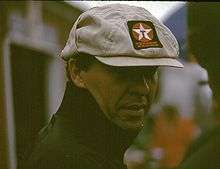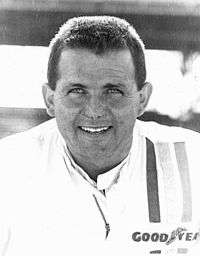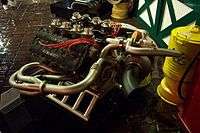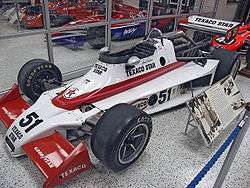1978 Indianapolis 500
|
| |||||
| Indianapolis Motor Speedway | |||||
|---|---|---|---|---|---|
| Indianapolis 500 | |||||
| Sanctioning body | USAC | ||||
| Season | 1978 USAC Trail | ||||
| Date | May 28, 1978 | ||||
| Winner | Al Unser, Sr. | ||||
| Winning team | Jim Hall/Chaparral | ||||
| Average speed | 161.363 mph (259.689 km/h) | ||||
| Pole position | Tom Sneva | ||||
| Pole speed | 202.156 mph (325.339 km/h) | ||||
| Fastest qualifier | Tom Sneva | ||||
| Rookie of the Year | Rick Mears & Larry Rice | ||||
| Most laps led | Al Unser, Sr. (121) | ||||
| Pre-race ceremonies | |||||
| National anthem | Purdue band | ||||
| "Back Home Again in Indiana" | Jim Nabors | ||||
| Starting Command | Mary F. Hulman | ||||
| Pace car | Chevrolet Corvette C3 | ||||
| Pace car driver | Jim Rathmann | ||||
| Attendance | 250,000 (estimated) | ||||
| TV in the United States | |||||
| Network | ABC | ||||
| Announcers | Jim McKay and Jackie Stewart | ||||
| Nielsen Ratings | 13.4 / 26 | ||||
| Chronology | |||||
| |||||
The 62nd International 500 Mile Sweepstakes was held at the Indianapolis Motor Speedway in Speedway, Indiana on Sunday, May 28, 1978. Danny Ongais dominated the early stages of the race but eventually dropped out with a blown engine. Al Unser, Sr. dominated the second half, and held a large lead late in the race. However, Unser bent his Lola's front wing during a pit stop on lap 180, causing his handling to go away over the final 20 laps. Second place Tom Sneva charged to catch the crippled Lola but came up 8 seconds short at the finish – the second-closest finish in Indy history to that point. Unser held off the challenge, and became a three-time winner of the 500.
Al Unser, Sr. entered the month having won the 1977 California 500 at Ontario the previous September. Later in the 1978 season, Unser would go on to win the Pocono 500 and the California 500, sweeping the "triple crown" of Indy car racing. As of 2014, he is the only driver in history to do so in the same season, and coupled with the win at Ontario in 1977, set a record by winning four straight 500-mile Indy car races.
Second year driver Janet Guthrie finished ninth, and it was later revealed she drove with a broken wrist.[1] It was the highest finish for a female driver in Indy history until Danica Patrick in 2005. During time trials, Tom Sneva, who had broken the 200 mph barrier a year earlier, bettered his own record. This time he managed to complete all four qualifying laps over 200 mph, setting once again new one and four lap records.
Tony Hulman, the popular owner and president of the track since 1945, died the previous October. For the first time, his widow Mary F. Hulman delivered the famous starting command. Along with the death of Hulman, the race was held just weeks after eight key members of USAC were killed in a plane crash. With dissent increasing amongst the participants about organizational issues and poor revenue, the 1978 race would be the final Indy 500 contested prior to the formation of CART and prior to the first open wheel "split."
Al Unser's victory was the first Indy triumph for the Cosworth DFX V8 engine. The British-based engine building company would go on to win the Indy 500 for ten consecutive years.
Race schedule
|
| ||||||||||||||||||||||||||||||||||||||||||||||||||||||||||||||
Practice and time trials
On Wednesday May 10, Mario Andretti turned a practice lap of 201.838 mph, faster than the track record. Minutes later, Danny Ongais upped the best speed to 201.974 mph. On Thursday May 11, rookie Rick Mears (200.0 mph) also joined the coveted "200 mph club" in practice. Johnny Rutherford (199.2 mph) and A. J. Foyt (199.158 mph) were also within striking distance.
On Friday May 12, the final day of practice before Pole Day, Mario Andretti shattered the unofficial track record, turning a lap of 203.482 mph. Also over 200 mph were Mears, Rutherford, and Foyt. Tom Sneva, the driver who broke the 200 mph barrier a year earlier, was the slowest of the three Penske cars, managing only a 196.3 mph lap during practice.
The first weekend of time trials was scheduled for May 13–14. Rain washed out the entire first weekend, and pole qualifying was moved to Saturday May 20.
The rainout complicated the schedule for Mario Andretti. He was forced to leave the track and fly to Zolder for the Grand Prix of Belgium. Arrangements were being made for another driver to qualify the car for him, and he would return to the cockpit for race day. With no track activity possible at Indy for Sunday, A. J. Foyt flew to Talladega and finished third in the NASCAR Winston 500.
During the second week of practice, Pancho Carter and Tom Sneva joined the "200 mph club." Sneva had a hand-timed lap of about 203.1 mph, inching closer to Andretti's mark from the previous week. Danny Ongais destroyed his primary car in a crash in turn four on Tuesday May 16. He was not seriously injured, but would have to qualify with his back-up car.
Pole Day – Saturday May 20

Pole day dawned with temperatures in the high 70s and low 80s. Qualifying started promptly at 11:00 a.m., with Johnny Rutherford first out on the track. He fell short of the 200 mph barrier on all four laps, and settled for an average of 197.098 mph.
At 12:03 p.m., Tom Sneva took to the track. Following in his own footsteps from the previous year, he set new all-time one and four lap track records. This time becoming the first driver in Indy history to complete all four qualifying laps over 200 mph.
- Lap 1 – 44.20 seconds, 203.620 mph (new 1-lap track record)
- Lap 2 – 44.43 seconds, 202.566 mph
- Lap 3 – 44.60 seconds, 201.794 mph
- Lap 4 – 44.85 seconds, 200.669 mph
- Total – 2:58.08, 202.156 mph (new 4-lap track record)
Due to changes in the rules in subsequent years, his one and four lap track records would stand until 1982. Sneva's four-lap average secured the pole position, his second pole in a row.
Sneva's Penske teammate, rookie Rick Mears, was the next car out. Mears completed three laps over 200 mph, and his four-lap average of 200.078 mph was a rookie speed record, and would be good enough for the front row.
Janet Guthrie returned for her second start, and qualified strongly at 190.325 mph. At 12:39 p.m., Danny Ongais made it an "all 200 mph" front row, securing second starting position at 200.122 mph.
After practicing over 200 mph, A. J. Foyt was forced to wave off his run, and missed his chance to qualify in the pole round. Mike Hiss was hired by Penske to drive substitute for Mario Andretti during time trials. He qualified the car with a respectable speed of 194.647 mph (8th). However, on race day, Andretti would get back in the car, and he would be forced to line up in the 33rd starting position due to the driver switch.
Rain late in the day hampered the qualifying attempts. The trip through the original qualifying line exhausted at 5 p.m., and Tom Sneva officially secured the pole position. Several drivers including Bobby Unser, A. J. Foyt, and Pancho Carter, were unable to qualify during the pole round. At 5 p.m., the "third day" of time trials officially commenced, and those drivers would line up behind the cars from the pole round.
The day ended with the field filled to 20 cars. Bobby Unser finishes his run as a "third day" qualifier in the rain. The track was closed for the day as soon as Unser returned to the pits at 5:11 p.m.
Bump Day – Sunday May 21

The final day of time trials opened with 13 spots unfilled. A. J. Foyt (200.120 mph) was the fastest of the day. His speed was tied for second-fastest, but as a final day qualifier, he would line up 20th.
Roger Rager was the only major on-track incident of the day. On his second warm-up lap, he hit the outside wall in turn four, suffering an injured hand. He would miss the race. Larry Cannon brushed the wall on his second qualifying lap, and Dick Simon brushed the wall on the mainstretch shaking down a car for Bill Puterbaugh. The car lost two wheels and it was too late in the day for the car to be repaired.
In the final hour, there was one spot left in the field when Bob Harkey was preparing to make his attempt. Jim Hurtubise, who had once again entered his now-infamous Mallard/Offy front-engined car, had been denied the permission to qualify, due to lack of speed. USAC had decided to set a 180 mph minimum speed in order to pass "final" inspection, receive the appropriate sticker, and be allowed to make a qualifying attempt. They deemed Hurtubise ineligible, claiming he had not broken 175 mph,[2][3] despite some claiming he had lapped over 184 mph.[2] Hurtubise considered the ruling a personal harassment, lies, and an effort by USAC, Goodyear, and the Speedway to single him out and keep him from qualifying.[3] After being a popular fixture amongst the fans for many years, several episodes of antics had caused some to begin to view Hurtubise unfavorably.[4] Hurtubise got into a heated exchange with chief steward Tom Binford, then proceeded to climb into Harkey's car, shouting "If I can't qualify, no one can!"[4] After a few minutes, Hurtubise was coaxed out of the car, and Harkey climbed in to crank it up. With some encouragement from the crowd, Hurtubise then jumped in front of Harkey, preventing him from pulling out of the pits.[2] He had to be restrained by safety patrol members, and Harkey managed to pull away. While Harkey was on the backstretch of his warm-up lap,[3] Hurtubise jumped over the pit wall and ran out on the race track in order to disrupt and halt the qualifying attempt.[2] Running down the mainstretch, several guards chased after him. Hurtubise was tackled by John Martin and was then detained by police.[2][4] By this time, the crowd's opinion had changed, and they began booing and jeering Hurtubise for going too far by disrupting qualifying. Hurtubise was banned from the track for the remainder of the month.[3]
Harkey managed to finish his qualifying attempt without incident, but his speed was not fast enough to stand. Within twenty minutes, Harkey was bumped by Joe Saldana. The day closed with Cliff Hucul bumping Graham McRae with two minutes left in the day.
After missing time trials, Mario Andretti won the Grand Prix of Belgium. He traveled back to Indianapolis during the week, and would be back in time for Carburetion Day "tests."
Starting grid
| Row | Inside | Middle | Outside |
|---|---|---|---|
| 1 | |||
| 2 | |||
| 3 | |||
| 4 | |||
| 5 | |||
| 6 | |||
| 7 | |||
| 8 | |||
| 9 | |||
| 10 | |||
| 11 |
Alternates
- First alternate: Graham McRae (#33, #34) – Bumped
- Second alternate: Bob Harkey (#42) – Bumped
Failed to qualify
- Al Loquasto (#86) – Bumped
- Larry "Boom Boom" Cannon (#85) – Too slow
- Bill Vukovich, Jr. (#18, #93) – Incomplete qualifying run
- John Martin (#28) – Incomplete qualifying runs
- Bubby Jones (#18) – Incomplete qualifying runs
- Gary Irvin (R) (#9) – Incomplete qualifying run
- Roger Rager (R) (#9, #97) – Wrecked during qualifying attempt
- Mike Hiss (#7, #66) – Substitute driver; qualified car for Mario Andretti
- Lee Kunzman (#90)
- Bobby Olivero (#78)
- Eldon Rasmussen (#58)
- Jim Hurtubise – Barred from making a qualifying attempt due to lack of speed; detained by police due after running out on the track to disrupt time trials.
Race summary

Start
Race day dawned hot and humid, with temperatures in the high 80s (°F). After the death of Tony Hulman, the starting command was recited by his widow Mary F. Hulman. With Janet Guthrie in the field once again, the traditional command was again tweaked. This time command was worded "Lady and Gentlemen, start your engines!"
During the pace laps, Gary Bettenhausen pulled into the pits with mechanical trouble, and missed the start. At the green flag, Danny Ongais darted into the lead, with Tom Sneva falling in line behind him in second. Rick Mears suddenly faded and pulled to the outside, and was passed by several cars. Ongais completed the first lap at a record speed of 185.185 mph.
Sheldon Kinser stalled on the backstretch, and brought out the yellow light for three laps. Rick Mears ducked into the pits for an unscheduled stop. He had forgotten to fasten his helmet strap, and nearly lost his helmet at the start of the race. He was able to properly fasten his helmet, and returned to the race.[5]
The green came back out on lap 5, with Ongais pulling out to a comfortable lead. Cliff Hucul went to pits, and was out of the race with a broken oil line.
First half
Mario Andretti quickly charged from last starting position to run as high as 13th in the early going. However, he was forced to pit to change a bad spark plug wire. He lost 8 laps, and was effectively out of contention for the rest of the day.
On lap 26, Spike Gehlhausen crashed exiting turn 2, and came to rest along the outside wall on the backstretch. Leader Danny Ongais was in the pits when the yellow came out, which gave the lead temporarily to Steve Krisiloff. However, under the yellow light condition, Krisiloff violated the PACER light rules, and was penalized one lap. That gave the lead to Tom Sneva. With Ongais in second right behind Sneva, the green light came back on down the backstretch on lap 31. Sneva led for barely a lap, and Ongais passed him for the lead the next time by.
Salt Walther dropped out with a bad clutch, and proceeded to rant his frustration of his chief mechanic Tommy Smith during a heated television interview.
Danny Ongais led 68 of the first 75 laps. The team reported that Ongais had lost his two-way radio, and was forced to communicate only by sign boards for the rest of the race.
Al Unser, Sr. took the lead for the first time on lap 76. he held the lead at the halfway point. A. J. Foyt, who had charged near the front early on, started to fade, and after long pit stops, was laps down to the leaders. Janet Guthrie, on the other hand, was moving up into the top ten.
Second half
Rookie Rick Mears dropped out after 103 laps with a blown engine. By lap 120, thirteen cars were out of the race, with hot conditions contributing to the attrition.
Al Unser, Sr. led, with Danny Ongais and Tom Sneva in the top three. Unser continued to hold a small lead over Ongais, with his crew's efficient and quick pit stops increasing the margin.
Suddenly on lap 145, second place Danny Ongais came into the pits with smoke pouring from the car. After having led 71 laps (nearly half the race up to that point), Ongais was out with a blown engine.
Finish
Al Unser, Sr. led second place Tom Sneva by over 20 seconds. Those were the only two cars left on the lead lap. On lap 180, Unser came onto the pits for his final stop. Unser overshot his pit box by a few feet, and hit a spare tire with his front wing. The team decided not to changes tires, and filled the car with fuel only. His stop was 17 seconds, his worst pit stop of the day.
One lap later, Tom Sneva pitted, taking fuel only. His pit stop, however, was not fast, and he did not immediately gain ground on Unser. With a 30-second lead, Unser had 19 laps to victory. However, his front wing was damaged from hitting the tire, and Unser's handling was starting to go away. Sneva began cutting away at his lead, by about a second per lap.
With three laps to go, Sneva had cut the lead to 14 seconds. Then with one lap to go, it was down to 10 seconds. On the final lap, third place Gordon Johncock slipped by Unser to get one of his laps back. Unser nursed the car around on the final lap, and won this third Indy 500. Second place Tom Sneva finished 8.09 seconds behind, the second-closest finish in Indy history to that point.
Wally Dallenbach and A. J. Foyt both stalled on the course out of fuel, but both finished strongly, 5th and 7th, respectively. Janet Guthrie finished 9th, and revealed after the race that she drove with a fractured wrist. Two days before the race, she fell during a charity tennis match, suffering the injury.
Box score
| Finish | Start | No | Name | Qual | Rank | Laps | Led | Status |
|---|---|---|---|---|---|---|---|---|
| 1 | 5 | 2 | 196.474 | 7 | 200 | 121 | Running | |
| 2 | 1 | 1 | 202.156 | 1 | 200 | 3 | Running | |
| 3 | 6 | 20 | 195.833 | 8 | 199 | 0 | Flagged | |
| 4 | 13 | 40 | 191.255 | 19 | 198 | 5 | Flagged | |
| 5 | 7 | 6 | 195.233 | 9 | 195 | 0 | Flagged | |
| 6 | 19 | 48 | 194.658 | 10 | 195 | 0 | Flagged | |
| 7 | 20 | 14 | 200.122 | 2 | 191 | 0 | Flagged | |
| 8 | 23 | 84 | 192.626 | 16 | 191 | 0 | Flagged | |
| 9 | 15 | 51 | 190.325 | 22 | 190 | 0 | Flagged | |
| 10 | 8 | 16 | 194.280 | 12 | 186 | 0 | Flagged | |
| 11 | 30 | 35 | 187.392 | 31 | 186 | 0 | Engine | |
| 12 | 33 | 7 | 194.647 | 11 | 185 | 0 | Flagged | |
| 13 | 4 | 4 | 197.098 | 5 | 180 | 0 | Flagged | |
| 14 | 28 | 88 | 187.549 | 29 | 176 | 0 | Flagged | |
| 15 | 24 | 69 | 190.809 | 21 | 173 | 0 | Flagged | |
| 16 | 31 | 98 | 187.324 | 32 | 147 | 0 | Engine | |
| 17 | 25 | 78 | 188.719 | 26 | 146 | 0 | Turbocharger | |
| 18 | 2 | 25 | 200.122 | 3 | 145 | 71 | Blown Engine | |
| 19 | 10 | 17 | 192.967 | 15 | 138 | 0 | Wheel Bearing | |
| 20 | 26 | 26 | 188.058 | 27 | 132 | 0 | Engine | |
| 21 | 18 | 43 | 189.115 | 25 | 107 | 0 | Rod | |
| 22 | 9 | 80 | 193.434 | 13 | 104 | 0 | Oil Pressure | |
| 23 | 3 | 71 | 200.078 | 4 | 103 | 0 | Engine | |
| 24 | 21 | 8 | 196.829 | 6 | 92 | 0 | Header | |
| 25 | 11 | 11 | 192.256 | 17 | 82 | 0 | Clutch | |
| 26 | 17 | 39 | 189.723 | 24 | 58 | 0 | 1/2-time gear | |
| 27 | 14 | 22 | 190.941 | 20 | 25 | 0 | Oil Leak | |
| 28 | 22 | 77 | 193.226 | 14 | 24 | 0 | Clutch | |
| 29 | 16 | 19 | 190.325 | 23 | 23 | 0 | Crash T2 | |
| 30 | 29 | 47 | 187.520 | 30 | 22 | 0 | Oil Pressure | |
| 31 | 32 | 30 | 187.266 | 33 | 18 | 0 | Transmission | |
| 32 | 12 | 24 | 192.051 | 18 | 15 | 0 | Oil Pressure | |
| 33 | 27 | 29 | 187.805 | 28 | 4 | 0 | Oil Line | |
Broadcasting
Radio
The race was carried live on the IMS Radio Network. Paul Page served as anchor for the second year. Lou Palmer reported from victory lane. Mike Hiss, who had served as a substitute driver for Mario Andretti during time trials, served as the "driver expert."
This would be the 31st and final year for Jim Shelton on the crew. After eleven previous appearances, Fred Agabashian also had departed from the crew.
| Indianapolis Motor Speedway Radio Network | ||
|---|---|---|
| Booth Announcers | Turn Reporters | Pit/garage reporters |
|
Chief Announcer: Paul Page |
Turn 1: Ron Carrell |
Jerry Baker (north pits) Chuck Marlowe (north-center pits) Luke Walton (south-center pits) Lou Palmer (south pits) Bob Forbes (garages) |
Television
The race was carried in the United States on ABC Sports on a same-day tape delay basis. Jim McKay anchored the broadcast.
The broadcast has re-aired on ESPN Classic since May 2011.
| ABC Television | |
|---|---|
| Booth Announcers | Pit/garage reporters |
|
Host: Chris Schenkel |
Chris Economaki Bill Flemming Sam Posey |
Gallery
| Wikimedia Commons has media related to 1978 Indianapolis 500. |
-
1978 Corvette pace car
-

Janet Guthrie's 1978 entry
Notes
See also
References
- ↑ "Janet Proves Her Point". Milwaukee Sentinel. 1978-05-29. Retrieved 2012-04-03.
- 1 2 3 4 5 "'Herk' Can Always Make It Interesting". Times-Union. 1978-05-22. Retrieved 2012-04-04.
- 1 2 3 4 "Jim Hurtubise has been Indy's 'Nice Guy' this year". The Madison Courier. 1979-05-18. Retrieved 2012-04-05.
- 1 2 3 Donald Davidson; Rick Shaffer (2006). Autocourse Official History of the Indianapolis 500. MBI Publishing Company. p. 222.
- ↑ Wittenmyer, Gordon (1989-05-28). "Mears Uses A Good Yawn For Fast Lap". Sun-Sentinel. Retrieved 2012-04-04.
Works cited
- 1978 Indianapolis 500 Official Track Report
- Indianapolis 500 History: Race & All-Time Stats – Official Site
- 1978 Indianapolis 500 Radio Broadcast, Indianapolis Motor Speedway Radio Network
| 1977 Indianapolis 500 A.J. Foyt |
1978 Indianapolis 500 Al Unser |
1979 Indianapolis 500 Rick Mears |